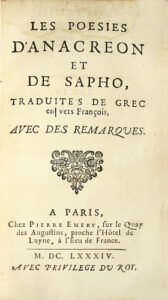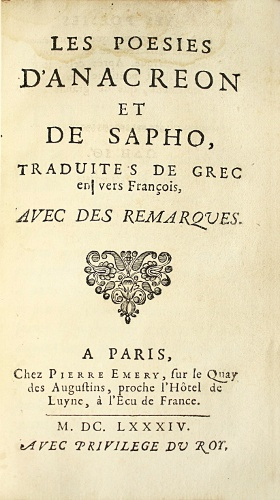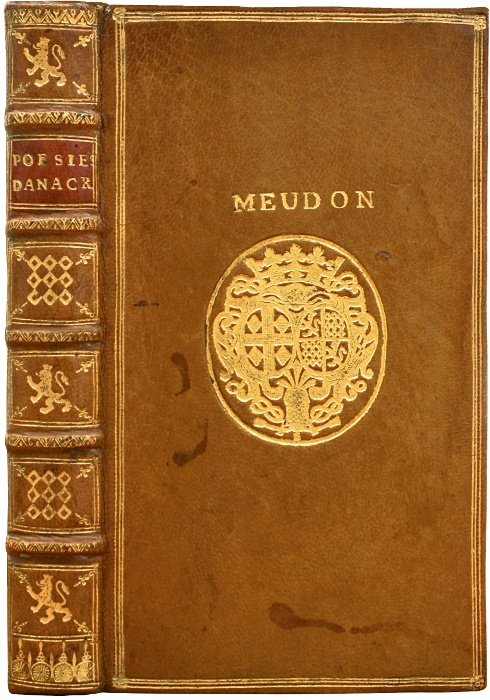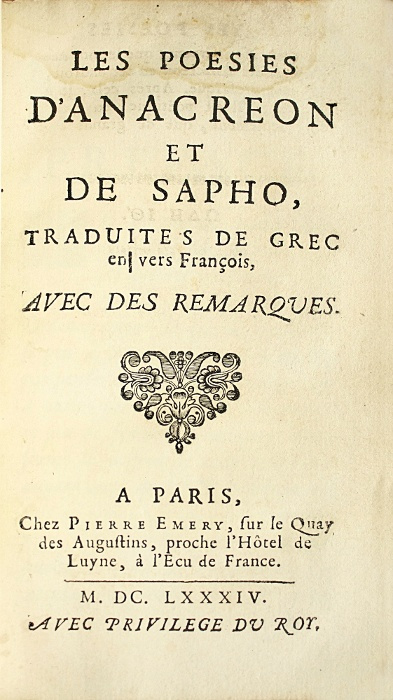Paris, Pierre Emery, 1684. Avec Privilege du Roy.
12mo [158 x 90 mm] of (1) bl.l., (14) ll., 390 pp., (1) l. of errata, (1) bl.l. Full contemporary citron morocco, triple gilt fillet on the covers, coat of arms and mention “Meudon” at the center of the covers, spine ribbed and decorated with coat of arms, red morocco lettering piece, inner gilt border, gilt over marbled edges. Contemporary binding.
First edition of Anacreon’s poems translated into French by Longepierre, the famous bibliophile under the reign of Louis XIV, who had adopted the Golden Fleece symbol as an heraldic emblem.
Brunet, I, 254; Barbier, III, 924.
Anacreon, Greek poet from the 6th century before Christ, gained immortality with his poems. With extreme simplicity and jolly grace, Anacreon sings here, not passion, like his predecessors, the Lesbos poets, but the games of love, the whims of desire, the passing pleasures. This exquisite sweetness, this surrender to pleasures as they come, make of Anacreon the most Ionian of the Greek poets. His easy genius earned him lots of admirers.
“Anacreon knew a long posthumous glory; in Rome, Horace and Catullus knew his works by heart and imitated them. All these poems were repeated by Henri Estienne when he published, in 1554, the Anacreontic poems that raised the enthusiasm of the Pléiade. Rémi Belleau made publish, in 1556, a nice translation in French verses, the first one ever made.”
Jacques Brosse.
“Longepierre, born in Dijon in 1659, was very early very keen on studying, and his father enjoyed supporting him; it was him, they say, who advised him to translate into French verses some of these Greek poets who had become familiar to him. Still very young, he published translations of Anacreon, Sappho, Theocritus, Bion and Moschus: the notes accompanying these translations prove that Longepierre understood and felt quite well these authors”. Michaud.
Precious and superb copy bound in contemporary citron morocco with the arms and coat of arms of Jeanne-Baptiste d’Albert de Luynes, comtesse de Verrue (1670-1736), coming from the library of her country house in Meudon.
“The comtesse de Verrue loved the arts passionately: paintings, sculptures, engravings, drawings, furniture, porcelain, she collected everything that was beautiful; her book collection was containing a majority of novels and plays was made of 18,000 chosen volumes, most of them bound by the best contemporary artists. Above her arms, she often had stamped a mention: “Paris”, “Meudon” (where she owned a country house) or “St Port” (currently Seine-Porte, near Melun). Almost all of her volumes also had on the spine and corners of the covers her coat of arms alternate.”
Olivier, pl. 799.
Provenance: from the collections of the Comtesse de Verrue (coat of arms) and Edouard Moura (engraved ex libris).




